The launch of NASA’s second Mars Exploration rover, Opportunity, has been delayed again to Monday, July 7 as early as 0243 GMT (10:43 pm EDT Sunday). The delay will give technicians time to ensure that the booster’s cork insulation is properly adhered. If all goes well, Opportunity will blast off from the Kennedy Space Center in Florida on board a Delta 2 rocket and follow its partner spacecraft, Spirit, already en route to the Red Planet. Launch windows for the spacecraft are available until July 15.
Mars Express Power Problems
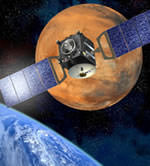
Image credit: ESA
Operators with the European Space Agency are currently testing various systems on the Mars Express spacecraft, and it looks like there’s a bit of a problem. It seems that there’s a connection problem between the spacecraft’s solar panels and its power conditioning system. If they can’t fix this problem, the spacecraft will only be able to operate at 70% power; however, it will still be able to perform nearly all of its objectives for the mission. Ground engineers will begin tests on the Beagle 2 lander on July 4.
ESA?s Mars Express spacecraft is progressing further every day on its journey to the Red Planet. Everything is set for arrival at Mars on the night of 25 December 2003, after a journey of about 400 million kilometres. In the weeks since its launch, engineers have started to thoroughly test the spacecraft and its equipment.
This testing phase is standard for all spacecraft on the way to their destination. Known as commissioning, it began 3 weeks after the launch. During this time, ground controllers sent signals to each of the orbiter’s seven instruments to switch them on and verify their health status.
As well as commissioning the instruments, the ground controllers also tested each of the spacecraft?s subsystems. There was a thrilling moment when one of the on-board computer memory units, known as the Solid State Mass Memory (SSMM), seemed to not respond properly during the instruments check-out. Good progress has been made on this issue in the last few days: a test involving all instruments was completed successfully by recording and recovering the data through the SSMM.
Unfortunately, during the commissioning of the power subsystem, ground engineers recorded an interconnection problem between the solar arrays and the power conditioning unit on board the spacecraft. This means approximately 70% of the power generated by the solar arrays is available for the satellite and its payload to use. This anomaly has no effect on the state of the spacecraft and has no impact on the mission during the whole trip to Mars, including the orbit insertion phase once at destination.
Despite this, the experts analysing the anomaly believe that even with this power shortage, the nominal Mars observation mission will be achievable. However, satellite payload operations may have to be reviewed for certain short periods of the mission.
Ground engineers are now preparing for the last of the payload?s tests: the Beagle-2 lander will undergo its check-out on 4-5 July 2003. The experts are looking confidently to it. “In fact,” says Rudolf Schmidt, Mars Express Project Manager, “overall, the spacecraft is in good shape. We are simply getting to know its personality.”
Original Source: ESA News Release
Opportunity Launch Rescheduled
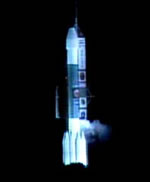
Image credit: NASA/JPL
NASA has decided to push back the launch of its second rover, Opportunity, to no earlier than Sunday, July 6 at 0251 GMT (10:51 pm EDT Saturday). The delays give engineers time to repair insulation which is failing to adhere properly to the first stage of the Delta II rocket. The launch was delayed over the weekend because of poor weather. If all goes well, Opportunity will follow NASA’s previous rover, Spirit, already en route to Mars to search for evidence of life on the Red Planet.
The launch of the MER-B ?Opportunity? Mars Exploration Rover aboard the Boeing Delta II Heavy Iaunch vehicle has been postponed to no earlier than Saturday, July 5.
A decision was made today to take additional time to perform tests on the process used to bond the cork insulation to the surface of the Delta II launch vehicle. These tests should be complete late on Wednesday.
The launch times on Saturday evening are: 10:51:25 p.m. and 11:34:05 p.m. EDT.
Original Source: NASA News Release
Opportunity Set for Weekend Launch
NASA’s second Mars Explorer rover, Opportunity, is set for launch on the weekend atop a Delta II rocket from Cape Canaveral, Florida. If all goes well, the spacecraft will lift off at 0356 GMT Sunday (11:56 pm EDT Saturday) and join the previous rover, Spirit, en route to the Red Planet. Weather forecasts currently give the rover a 60% chance of acceptable conditions for flight. Opportunity is targeted to land at Meridiani Planum, which is a prime location for search for past life on Mars.
Odyssey Reveals More of Frosty Mars
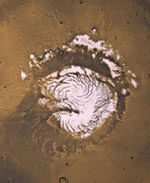
Image credit: NASA/JPL
It turns out that Mars has been hiding its water underneath a layer of dry ice. By tracking the seasonal changes at Mars northern ice cap, NASA’s Mars Odyssey spacecraft has watched how a layer of carbon dioxide permafrost comes and goes. When the permafrost dissipates in the Spring, Mars reveals a soil layer mixed with large amounts of water ice. In some places, the water ice content is more than 90% by volume. During the winter, the dry ice permafrost can reach more than a metre in thickness.
NASA’s Mars Odyssey spacecraft is revealing new details about the intriguing and dynamic character of the frozen layers now known to dominate the high northern latitudes of Mars. The implications have a bearing on science strategies for future missions in the search of habitats.
Odyssey’s neutron and gamma-ray sensors have tracked seasonal changes as layers of “dry ice” (carbon-dioxide frost or snow) accumulate during northern Mars’ winter and then dissipate in the spring, exposing a soil layer rich in water ice– the martian counterpart to permafrost.
Researchers used measurements of martian neutrons combined with height measurements from the laser altimeter on another NASA spacecraft, Mars Global Surveyor, to monitor the amount of dry ice during the northern winter and spring seasons.
“Once the carbon-dioxide layer disappears, we see even more water ice in northern latitudes than Odyssey found last year in southern latitudes,” said Odyssey’s Dr. Igor Mitrofanov of the Russian Space Research Institute (IKI), Moscow, lead author of a paper in the June 27 issue of the journal Science. “In some places, the water ice content is more than 90 percent by volume,” he said. Mitrofanov and co-authors used the changing nature of the relief of these regions, measured more than 2 years ago by the Global Surveyor’s laser altimeter science team, to explore the implications of the changes.
Mars Odyssey’s trio of instruments, called the gamma-ray spectrometer suite, can identify elements in the top meter (3 feet) or so of Mars’ surface. Mars Global Surveyor’s laser altimeter is precise enough to monitor meter-scale changes in the thickness of the seasonal frost, which can accumulate to depths greater than a meter. The new findings show a correlation in the springtime between Odyssey’s detection of dissipating carbon dioxide in latitudes poleward of 65 degrees north and Global Surveyor’s measurement of the thinning of the frost layer in prior years.
“Odyssey’s high-energy neutron detector allows us to measure the thickness of carbon dioxide at lower latitudes, where Global Surveyor’s altimeter does not have enough sensitivity,” Mitrofanov said. “On the other hand, the neutron detector loses sensitivity to measure carbon-dioxide thickness greater than one meter (3 feet), where the altimeter obtained reliable data. Working together, we can examine the whole range of dry-ice snow accumulations.”
“The synergy between the measurements from our two ‘eyes in the skies of Mars’ has enabled these new findings about the nature of near-surface frozen materials, and suggests compelling places to visit in future missions in order to understand habitats on Mars,” said Dr. Jim Garvin, NASA’s Lead Scientist for Mars Exploration.
Another report, to be published in the Journal of Geophysical Research-Planets, combines measurements from Odyssey and Global Surveyor to provide indications of how densely the winter layer of carbon-dioxide frost or snow is packed at northern latitudes greater than 85 degrees. The Odyssey data are used to estimate the mass of the deposit, which can then be compared with the thickness to obtain a density. The dry-ice layer appears to have a fluffy texture, like freshly fallen snow, according to the report by Dr. William Feldman of Los Alamos National Laboratory, N.M., and 11 co-authors. The study also found that once the dry ice disappears, the remaining surface near the pole is composed almost entirely of water ice.
“Mars is constantly changing,” said Dr. Jeffrey Plaut, Mars Odyssey project scientist at NASA’s Jet Propulsion Laboratory, Pasadena, Calif. With Mars Odyssey, we plan to examine these dynamics through additional seasons, to watch how the winter accumulations of carbon dioxide on each pole interact with the atmosphere in the current climate regime.”
Mitrofanov’s co-authors include researchers at the Institute for Space Research of the Russian Academy of Science, Moscow; MIT, Cambridge, MA; NASA’s Goddard Space Flight Center, Greenbelt, Md.; TechSource, Santa Fe, N.M.; and NASA Headquarters, Washington. Feldman’s co-authors include researchers at New Mexico State University, Las Cruces; Cornell University, Ithaca, N.Y.; and Observatoire Midi-Pyrenees, Toulouse, France.
JPL manages the Mars Odyssey and Mars Global Surveyor missions for NASA’s Office of Space Science in Washington. Investigators at Arizona State University, the University of Arizona, and NASA’s Johnson Space Center, Houston, built and operate Odyssey science instruments. The Russian Aviation and Space Agency supplied the high-energy neutron detector and Los Alamos National Laboratory supplied the neutron spectrometer. NASA’s Goddard Space Flight Center supplied Global Surveyor’s laser altimeter. Information about NASA’s Mars exploration program is available online at: http://mars.jpl.nasa.gov
Original Source: NASA/JPL News Release
Summer Will Bring Mars’ Closest Approach
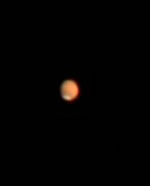
Image credit: Ron Wayman
Earth and Mars are rapidly converging, and are expected to reach their closest point on August 27, 2003. Already amateur astronomers with modest telescopes are reporting they can see features on the surface of Mars with greater clarity, including the planet’s polar ice caps. On August 27, the two planets will only be 56 million km apart; the closest they’ve been for 60,000 years. The planet is currently visible in the morning sky, but over the course of the summer it will move to the point that it’s easy to spot in the evening sky – it’ll be hard to miss since it’ll be nearly the brightest object in the sky.
Count slowly: one one-thousand, two one-thousand, three one-thousand…. You just got about 30 km closer to the planet Mars.
Earth and Mars are rapidly converging. On August 27, 2003–the date of closest approach–the two worlds will be 56 million km apart. That’s a long way by Earth standards, but only a short distance on the scale of the solar system. NASA, the European Space Agency and Japan are all sending spacecraft to Mars this year. It’s a good time to go.
Between now and August, Mars will brighten until it “blazes forth against the dark background of space with a splendor that outshines Sirius and rivals the giant Jupiter himself.” Astronomer Percival Lowell, who famously mapped the canals of Mars, wrote those words to describe the planet during a similar close encounter in the 19th century.
Already Mars is eye-catching. You can see it this month in the morning sky–bright, steady and remarkably red. Only Venus near the sun is brighter.
Amateur astronomers looking through backyard telescopes have reported in recent days great views of Mars’s south polar cap. Made of frozen water and carbon dioxide (“dry ice”), it reflects sunlight well. “I can see the polar ice vividly using my 8-inch telescope,” says Ron Wayman of Tampa, Florida. He’s also spotted “some faint darker-shaded areas on the surface.”
Such markings will become clearer in the weeks ahead. On June 1st Mars was 12.5 arcseconds across and it glowed like a -1st magnitude star. On August 27th it will be twice as wide (25 arcseconds) and six times brighter (magnitude -2.9).
Much has been made of the fact that the August 27th encounter with Mars is the closest in some 60,000 years. Neanderthals were the last to observe Mars so favorably placed. This is true. It’s also a bit of hype. Mars and Earth have been almost this close many times in recent history.
Some examples: Aug. 23, 1924; Aug. 18, 1845; Aug. 13, 1766. In each case Mars and Earth were approximately 56 million km apart.
Astronomers call these close encounters “perihelic oppositions.” Perihelic means Mars is near perihelion–its closest approach to the sun. (The orbit of Mars, like that of all planets, is an ellipse, so the distance between the sun and Mars varies.) Opposition means that the sun, Earth and Mars are in a straight line with Earth in the middle. Mars and the sun are on opposite sides of the sky. When Mars is at opposition and at perihelion–at the same time–it is very close to Earth.
August 27th is indeed the best perihelic opposition since the days of the Neanderthals, but it scarcely differs from other more recent ones. That’s fine because all perihelic oppositions of Mars are spectacular.
Mars is a morning planet now. You have to wake up early to see it. Soon, though, it will be more conveniently placed. By mid-July Mars will rise in the east around 11 p.m. local time. In late August it will appear as soon as the sun sets. It won’t be long before everyone can see Mars at a civilized hour.
We’ll be telling more stories about Mars in the weeks ahead. This one, though, is finished. Did you make it to the end? Congratulations! You’re now 2000 km closer to Mars.
Original Source: NASA Science Story
New View of Mars
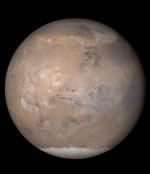
Image credit: NASA/MSSS
The Mars Global Surveyor spacecraft takes a complete picture of Mars every day to track weather and surface frost across the planet. Surveyor has been tracking the planet this way since 1999, for almost two complete Martian years. This recently released image was taken on May 12, 2003 and shows the northern hemisphere in early autumn and the southern hemisphere in spring. The planet’s four large volcanoes are also visible on the left-hand side.
The Mars Global Surveyor (MGS) Mars Orbiter Camera (MOC) experiment consists of 3 different cameras: a narrow angle imager that provides the black-and-white high resolution views (up to 1.4 meters per pixel) of Mars, and 2 wide angle cameras, observing in red and blue wavelengths, from which color views of the entire planet are assembled each day. The wide angle cameras provide a daily record of changes in martian weather and surface frost as the seasons progress. MGS MOC has obtained a record of martian weather spanning a little over 2 martian years since it began systematic observations in March 1999.
The view of Mars shown here was assembled from MOC daily global images obtained on May 12, 2003. At that time, the northern hemisphere was in early autumn, and the southern hemisphere in early spring. At the left/center of this view are the four large Tharsis volcanoes: Olympus Mons, Ascraeus Mons, Pavonis Mons, and Arsia Mons. Stretching across the center of the globe is the ~5,000 kilometers (~3,000 miles) long Valles Marineris trough system. The seasonal south polar carbon dioxide frost cap is visible at the bottom of this view. A dust storm sweeps across the plains of northern Acidalia at the upper right. North is up, east is right, sunlight illuminates the planet from the left.
Original Source: MSSS News Release
Controllers Delay Beagle 2 Tests
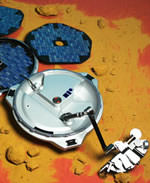
Image credit: ESA
The European Space Agency is in the process of testing various instruments on board the Mars Express spacecraft to make sure everything survived the launch from Earth. One series of tests on the Beagle 2 lander will be postponed until July to give engineers more time to understand a temporary error that occurred in one of Beagle 2’s memory modules. Once they’ve gotten to the bottom of it, ESA will proceed with the formal instrument checks to make sure Beagle 2 is ready for its landing on Mars.
The instruments on board ESA’s mission to Mars, Mars Express, are in the process of being tested to verify that they have survived the launch successfully and will work properly. One of these tests on the Mars Express lander, Beagle 2, has been postponed to the first week of July.
This will give engineers extra time to investigate a temporary anomaly that occurred in a memory unit, the so-called ‘Solid State Mass Memory’ (SSMM). The SSMM stores data from the instruments before sending them to Earth.
This anomaly happened last week during the test of OMEGA, one of Mars Express instruments. For a short period of time, the output of one part of the SSMM contained errors. The problem disappeared spontaneously. The affected memory unit is now working properly. To preserve the data which are stored in this part of the memory, while trying to understand why it occurred, the instrument checks have been rescheduled.
These kind of events are considered routine in a space mission, but engineers would like to understand the causes before re-starting the instrument tests.
Original Source: ESA News Release
Mars Surveyor Snaps Phobos
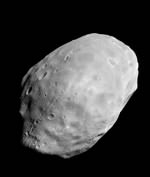
Image credit: NASA/JPL
NASA’s Mars Global Surveyor took several photos of Mars’ moon Phobos on June 1, 2003. The first image is a low-resolution shot of Phobos about to set behind the Red Planet; while the second, higher resolution image shows incredible details on the moon’s surface. Phobos orbits Mars three times a day at an average distance of only 9,378 kilometres – if you stood on the surface of Phobos, Mars would nearly fill the sky above.
Mars has two natural satellites, or moons, Phobos and Deimos. On 1 June 2003, the Mars Global Surveyor (MGS) spacecraft was slewed eastward to capture these views of the inner moon, Phobos, shortly before it set over the afternoon limb. Phobos orbits Mars about 3 times a day at a distance of about 6,000 km (3,728 mi). About 0.006 times the size of Earth’s Moon, Phobos is a potato-shaped object with dimensions approximately 27 by 22 by 18 kilometers (about 17 by 14 by 11 miles).
The first picture shown here is a color composite of four MGS Mars Orbiter Camera (MOC) wide angle images; the second is the same as the first, but indicates the location of Phobos. The third view is a MOC narrow angle image, taken at the same time as the wide angle views, showing details on the surface of the tiny moon.
Phobos is one of the darkest objects in the Solar System. Thus, four wide angle images were obtained to make the picture of Phobos over the martian limb: a pair of red and blue wide angle images was acquired for the limb, and a pair of separate images were required to see Phobos. The wide angle images illustrate the fact that Phobos is mostly colorless (dark gray); the faint orange/red hue in the wide angle picture is a combination of slight differences in the focal lengths of the blue and red cameras and the orange/red illumination provided by reflection of sunlight off Mars. To a person standing on Phobos, the red planet would fill most of the sky.
The high resolution image (bottom) was taken at the same time as the wide angle views. MGS was about 9,670 kilometers (6,010 miles) from Phobos when the picture was taken. At this distance, the image resolution is about 36 meters (118 ft.) per pixel; the maximum dimension of Phobos as seen in this image (the diagonal from lower left to upper right) is just over 24 km (15 mi). This is the “trailing” hemisphere, the part of Phobos that faces opposite the direction that the moon orbits Mars. This is a part of Phobos that was not seen by MOC in 1998, when MGS made several close flybys of the tiny moon.
The rows of grooves and aligned pits on Phobos are related to, and were probably caused by, a large meteor impact that occurred on the side of Phobos that is not seen here. That large crater, Stickney, was named for the maiden name of the wife of the astronomer that discovered Phobos and the other martian satellite, Deimos, in 1877, Asaph Hall.
Original Source: MSSS News Release
Opportunity Pushed Back a Day
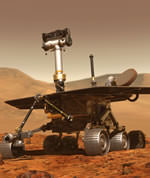
Image credit: NASA/JPL
NASA decided to push back the launch of the second Mars Explorer rover this week because of a minor problem with its Delta rocket. Engineers decided to replace a protective band of cork insulation on the rocket’s first stage. The time to make this replacement will push back the launch of “Opportunity” to Sunday, June 29 at 0356 GMT (11:56 pm Saturday EDT). If all goes well, Opportunity will follow Spirit, which is already on its way to Mars, and is expected to arrive in early January 2004.
The Flight Readiness Review was held today for the MER-B launch of the ?Opportunity? Mars Exploration Rover. Afterward, a decision was made to postpone the launch by at least a couple of days.
Based on routine post-test inspections, the launch team has elected to remove and replace a band of protective cork insulation on the Delta first stage. The location is below the forward attach points of the strap-on solid rocket boosters. Inspections of a second band located higher on the first stage are being performed.
The time necessary to do this work means a rescheduling of the launch to no earlier than Saturday, June 28 at 11:56:16 p.m. EDT. A firm date will be established on Monday after the engineering team reconvenes.
Original Source: NASA News Release
